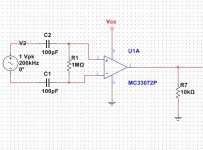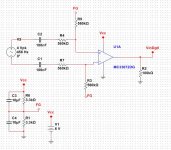A couple of things jump out - no provision for bias currents to the input stage and no way to establish the common-mode input voltage. Oh and also the opamp is probably going to be driven into non-linearity by that input signal if you resolve the earlier issues. Suggest you use a comparator rather than an opamp - TI has a nice new one here: Amplifiers and Linear - Comparator - TLV3201 - TI.com
OK, I have been reading a bit more - for example notes on the MC33072 (http://www.farnell.com/datasheets/78609.pdf
eg Figure 52. High Input Impedance Differential Amplifier)
One problem I can see is how do I account for inputs from say 100mV to 50 V?
One way is to use a resistor/divider networks and a range switch.
Is there a way to do this more "automatically" ?
eg Figure 52. High Input Impedance Differential Amplifier)
One problem I can see is how do I account for inputs from say 100mV to 50 V?
One way is to use a resistor/divider networks and a range switch.
Is there a way to do this more "automatically" ?
Using an opamp in this application can have a number of limitations. A much better choice is a comparitor, such as an LM 393. It is much faster and will provide a better squarewave as slew rate limiting is not a factor. Also the inputs need to have a reference to the power/ground of the opamp/comparitor, as well as some bias to establish a static state. Lastly you should have some positive feedback around the amp to give a bit of hysteresis so that you do not have any high frequency parasitic oscillation.
paul
paul
If you're looking for a circuit that flashes a light in time with the music, like a "colour organ" or beat indicator, some circuits use AGC, which gets a bit complicated. Others use a comparator where the reference input gets an averaged level so the comparator just responds to peaks... at least that how I interpreted the beat indicator circuit in the Gemini PS-626 mixer. This paper uses a similar approach: http://visiphon.com/papers/matt_aldrich_eeng236b.pdf
I have only simulated the very simple circuit below, but I am intending to convert an analogue waveform to square pulses, preferably without loading or affecting the input. Can you see anything wrong with it?
Wrong chip for the task. Opamps don't make very good comparators especially if you need speed. How fast is your signal changing as that will pretty much determine what comparator o use. Common inexpensive ones are the LM2903 dual and LM339 quad which are usable up to 500 KHz. The Analog Devices AD790 siwtches around 50 nS. I've used many of these in commercial products with excellent results. Read the daya sheets carefully as there are a lot of parameters.
G²
Thanks for your suggestions. After some simulation experimenting I have settled on something like this. When I build it, I may use a variety of chips, I believe I have a few LM393s that I can test with . The MC33072 is an exceptional chip however, I think it's going to work.
Attachments
Thanks for your suggestions. After some simulation experimenting I have settled on something like this. When I build it, I may use a variety of chips, I believe I have a few LM393s that I can test with . The MC33072 is an exceptional chip however, I think it's going to work.
Depending on what you're connecting it to it may or may not work as you expect. If you try to run into the clock input of a D flip flop like a CD4013 the rise time may be too long to trigger the flip flop. For that you'd still need to go through an inverter to speed up the transition. You're trying to make apple pie with tomatoes which never comes out right. Stop being obstinate and use the right chip.
If you do try the LM393 remember the output is open collector and will require a pullup resistor to work.
G²
- Status
- This old topic is closed. If you want to reopen this topic, contact a moderator using the "Report Post" button.
- Home
- Design & Build
- Equipment & Tools
- Analogue to digital

